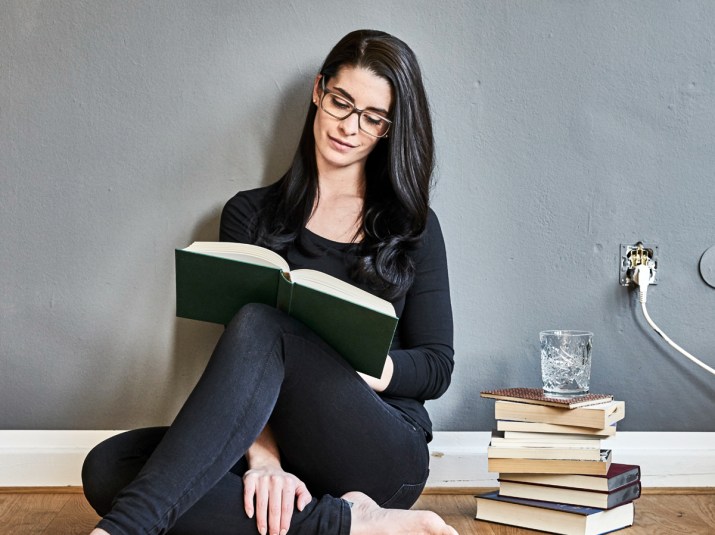4 Ways to Unlock Your Inner Genius and Conquer Any Problem

Yes, you are brilliant! Experts say tapping into your creativity can unleash a cascade of benefits from slashing stress to boosting your can-do.
From da Vinci to Einstein, history’s most celebrated minds were touched by a divine spark of genius. And we just weren’t blessed with that level of brilliance…right? Not so fast. Research shows that the brightest among us have all relied on a handful of down-to-earth strategies that we can easily emulate to boost our creativity, problem-solving abilities, and confidence. And because our brain can’t think creatively and negatively at the same time, new studies have found that intentionally unleashing our imagination stirs up a potent cocktail of positive emotions that tame anxiety, usher in calm, increase motivation, and generate lasting joy.
Ironically, the first step to unlocking our inner “genius” is removing the word itself from the pedestal we tend to place it on, says psychologist R. Keith Sawyer, PhD, author of Zig Zag: The Surprising Path to Greater Creativity ($18.85, Amazon), who admits to being a bit uncomfortable with the very term he studies. “‘Genius’ implies that these feats of the imagination are reserved for unique individuals, when the science shows that’s just not the case,” he says. “Creativity is rooted in everyday brain processes that we all have the power to develop—and tapping into those processes can be as easy as letting our minds wander or allowing ourselves to be curious about the world around us.”
Read on to learn the easy techniques history’s most inspired minds used to tap into their own creativity — and how to use your own limitless genius to outsmart stress!
Overwhelmed? Daydream like Leonardo da Vinci
You’ve been tasked with a new work project, but your plate is so full, you feel like you’re balancing the Leaning Tower of Pisa and it’s about to topple. “Creativity requires that we expand our field of thinking,” notes Deborah Anne Quibell, PhD, author of Deep Creativity: Seven Ways to Spark Your Creative Spirit ($12.20, Amazon). “But stress shrinks our focus to a tiny dot, curbing communication between brain cells, so that we can hardly think, let alone think creatively.”
The original Renaissance man was an accomplished daydreamer, sometimes making just one paint stroke before leaving a canvas to let his mind rest and reset. And as Lynne Everatt, author of The 5-Minute Recharge: 31 Proven Strategies to Refresh, Reset, and Become the Boss of Your Day ($17.54, Amazon), points out, this “lazy habit” is anything but. “Working for 52 minutes, then taking 17 minutes to disengage is proven to ignite original ideas.” That’s because mind wandering leads to crucial incubation periods so ideas from your subconscious can bubble to the surface.
Stuck in a rut? Ride a bike like Albert Einstein
Your sister invites you over to brainstorm ways to make your parents’ upcoming golden anniversary truly special, and while she’s is full of Pinterest-worthy ideas, you’re anxiously drawing a blank, waiting for a big idea to strike. “When that flash of insight doesn’t come, we start believing that we’re just uncreative,” says Sawyer. “Our culture tells us it’s common to solve problems with one big idea, but creativity works by taking small steps.”
Einstein’s smarts sprang from small sparks, not one big insight, says Sawyer. “Each idea built on the next, after he went down a few dead ends.” In fact, when he was stuck and stressed, he literally went down dead ends on his bike, because he knew what studies now prove: Exercise boosts creativity. And cycling is especially beneficial because balance engages more brain regions. No wonder Einstein said, “Life is like riding a bicycle. To keep your balance, you must keep moving.”
Questioning yourself? Talk to yourself like Maya Angelou
Your church is gearing up for a fund-raiser, and you have a million ideas about how to make it one for the record books. But instead of running with your plans, you second-guess them. “Early in the creative process, we tend to feel insecure about our embryonic ideas,” observes Sawyer. “But waiting until things are so-called ‘perfect’ actually blocks creativity, inhibiting our willingness to experiment and take risks.”
One of Maya Angelou’s creativity-sparking habits — reading her writing aloud as she worked — was so deceptively simple, it truly is genius. It even has a fancy name: “Externalizing your developing thoughts,” says Sawyer. “This process changes your thoughts by creating a dialogue with them.” In other words, don’t be afraid to put your kernel of an idea out there, even if that simply means telling it to yourself. It’ll help change your perspective, fueling new insights!
Suffered a setback? Start a journal like Marie Curie
You love taking an art class at the local community college, but when your teacher criticizes a painting you poured your heart into, you feel like ditching your brushes for good. “When we feel that a piece of ourselves is being judged, we recoil, feeling vulnerable,” notes Everatt. “That sense of rejection or disappointment can lead us to close ourselves off and deny our creative impulses in order to feel ‘safe’ again.”
To recover from such setbacks, take a page out of Marie Curie’s book. ”She was an avid journal writer,” says Everatt. “This helped her navigate both personal and professional challenges. Indeed, reflective writing, where you describe your feelings, is critical to creativity because it increases resilience. Studies show spending 10 minutes a day writing about your emotions without judgment boosts your confidence by sparking self-compassion and silencing your inner censor.
This story originally appeared in our print magazine.
We write about products we think our readers will like. If you buy them, we get a small share of the revenue from the supplier.
More From FIRST
Why Owning a Dog Could Be Good For Heart Health
6 Natural Ways to Ease Cravings, Headaches, and Other Common Health Bothers
















